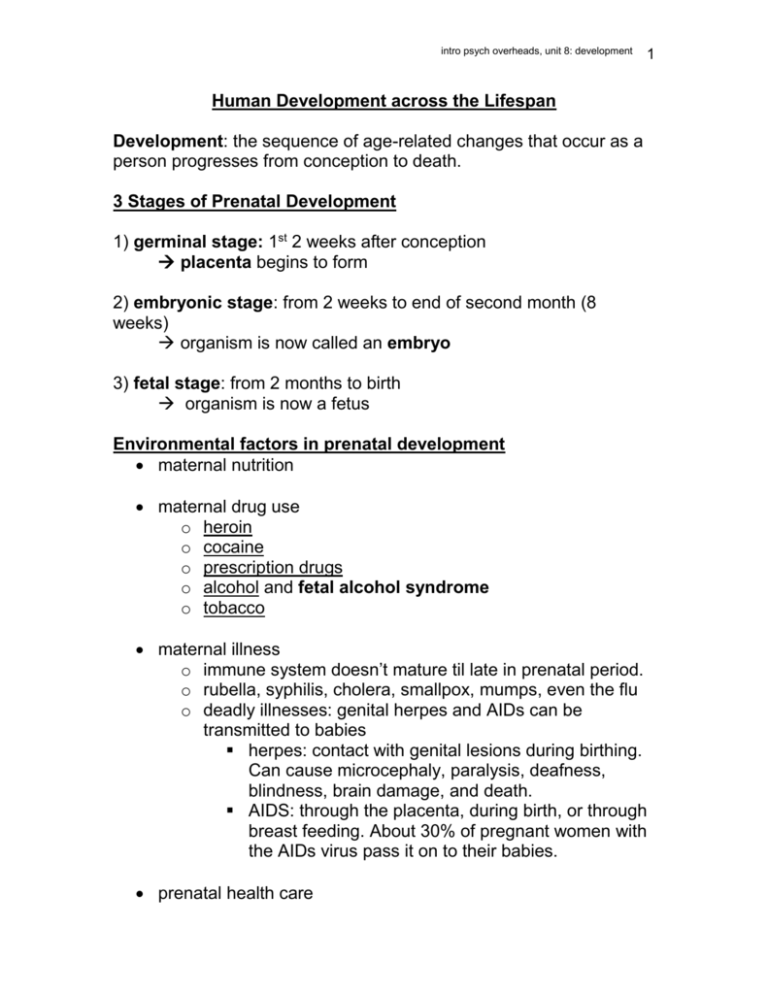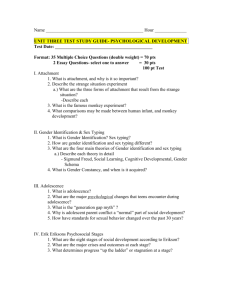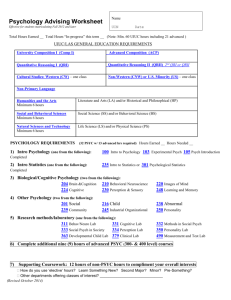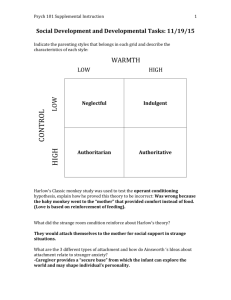Unit 8: Human Development across the Lifespan
advertisement

intro psych overheads, unit 8: development 1 Human Development across the Lifespan Development: the sequence of age-related changes that occur as a person progresses from conception to death. 3 Stages of Prenatal Development 1) germinal stage: 1st 2 weeks after conception placenta begins to form 2) embryonic stage: from 2 weeks to end of second month (8 weeks) organism is now called an embryo 3) fetal stage: from 2 months to birth organism is now a fetus Environmental factors in prenatal development maternal nutrition maternal drug use o heroin o cocaine o prescription drugs o alcohol and fetal alcohol syndrome o tobacco maternal illness o immune system doesn’t mature til late in prenatal period. o rubella, syphilis, cholera, smallpox, mumps, even the flu o deadly illnesses: genital herpes and AIDs can be transmitted to babies herpes: contact with genital lesions during birthing. Can cause microcephaly, paralysis, deafness, blindness, brain damage, and death. AIDS: through the placenta, during birth, or through breast feeding. About 30% of pregnant women with the AIDs virus pass it on to their babies. prenatal health care intro psych overheads, unit 8: development 2 Motor Development: the progression of muscular coordination required for physical activities. cephalocaudal trend: head-to-foot proximodistal trend: center-outward o growth happens in sudden bursts maturation: gradual unfolding of one’s genetic blueprint Developmental norms: median age at which individuals display various behaviours and abilities. Temperament: characteristic mood, activity level, emotional reactivity. Thomas & Chess (1977; 1989) temperament is well established by 2 to 3 months old 3 styles of temperament in most children 1) easy children (40%) 2) slow-to-warm-up children (15%) 3) difficult children (10%) --- The remaining 35% are mixes --Jerome Kagan (1991; 1992) 15-20% of infants display inhibited temperament 25-30% of infants exhibit uninhibited temperament stable into middle childhood, determined by genetic inheritance. Attachment: close, emotional bonds of affection that develop between infants and their caregivers. Initially babies show little preference for their mothers. By 6-8 months babies begin to show a preference for their mothers, and protest when separated from her. o Separation anxiety: emotional distress when separated from people with whom there is an attachment. intro psych overheads, unit 8: development 3 Patterns of attachment Secure attachment Anxious-ambivalent attachment Avoidant attachment Effects of secure attachment: securely attached infants exhibit secure attachments to fathers become resilient, competent toddlers with high self-esteem persistence, curiosity, self-reliance, leadership, peer relations at age 11, better social skills, more close friends advanced cognitive development in childhood and adolescence sets the tone for romantic relationships in adulthood gender roles, religious beliefs, ability to be intimate with others warning: all this is correlational data!!! Variables that might affect attachment Bonding at birth: does skin-on-skin contact after birth promote more effective attachment? There is no convincing evidence. Day Care: 2/3 of kids under 5 in the US get some kind of nonmaternal care o Belsky (1988; 1992): nonmaternal care for > 20 hours/week leads to insecure attachments o however the number with insecure attachment in day care is only slightly higher than the norm o lots of evidence that day care is not harmful in this way o day care can have beneficial effects on some youngsters’ social development Culture: there are differences in the proportions of kids who display the different attachment styles depending on what culture they are in. intro psych overheads, unit 8: development 4 Evolutionary perspectives on attachment: Bowlby (1969): Infants are wired to emit behaviour that triggers an affectionate response from adults and adults are wired to respond. Belsky’s theory (1999): o If parents have time/energy to be sensitive & responsive, the environment is stable, safe, rich in resources. This fosters a reproductive strategy that emphasizes fewer partners, more stable and enduring bonds, more parental investment in offspring. o If parents cannot be sensitive/responsive, the environment is unsafe, with few resources. This fosters a reproductive strategy that is opportunistic The development of personality Erik Erikson (1963): personality is shaped by how an individual deals with psychosocial crises in each of eight stages. Each crisis involves the struggle between 2 opposing tendencies. 1) 2) 3) 4) Trust vs. mistrust (1st year) Autonomy vs. shame and doubt (2nd and 3rd years) Initiative vs. guilt (ages 3 to 6) Industry vs. inferiority (6 through puberty) Cognitive Development: transitions in youngsters’ patterns of thinking, including reasoning, remembering, and problem solving. intro psych overheads, unit 8: development Jean Piaget: 4-stage theory of cognitive development 1) Sensorimotor period (birth to age 2) o gradual appearance of symbolic thought o object permanence: when a child recognizes that objects continue to exist even when they are no longer visible. not mastered til about 18 months old 2) Preoperational period (age 2 to 7) o unable to perform conservation tasks: awareness that physical quantities remain constant in spit of changes in their shape or appearance. o flaws in thinking centration irreversibility egocentrism animism: 3) Concrete Operational Period (age 7 to 11) o master reversibility and decentration, decline in egocentrism, gradual mastery of conservation o new problem-solving abilities 4) Formal operational period (age 11 and beyond): apply their operations to abstract concepts in addition to concrete objects o thinking is abstract, systematic, logical, and reflective. Evaluating Piaget saw children as active agents constructing their own worlds guided enormous quantities of research however, he underestimated young childrens’ cognitive development o object permanence develops earlier than he thought o preoperational kids are less egocentric and less prone to animism what about individual differences in development? people can display features of more than one stage the timetable varies across cultures 5 intro psych overheads, unit 8: development 6 Information Processing theory and development Attention: - Preschool kids have short attention spans and are easily distracted. - As kids get older their ability to attend for longer periods improves - Also get better at selectively focusing attention Memory: adults display infantile amnesia: an inability to remember experiences form their early years (usually no earlier than 3). o early memories are not very enduring o durable memories require language skills o older children acquire strategies for enhancing storage and retrieval Rehearsal (start using this around age 5) Organization (around age 9) Elaboration (after age 11) Speed of information processing: gets better as kids get older, and contributes to more effective use of memory. Moral development: development of the ability to discern right from wrong and to behave accordingly. Lawrence Kohlberg (1976): developed a 3-level theory of moral reasoning 1) Preconventional level 2) Conventional level 3) Postconventional level intro psych overheads, unit 8: development 7 Adolescence - peculiar to industrialized nations where lengthy education is necessary and therefore, prolonged economic dependency is the norm adolescent growth spurt: phase of rapid growth in height and weight, starting about age 11 for girls and age 13 for boys. pubescence: the 2-year span preceding puberty during which the changes leading to physical and sexual maturity take place o grow taller and heavier o develop secondary sex characteristics: features that distinguish one sex from another but that are not essential for reproduction puberty: the stage during which sexual functions reach maturity, marking the beginning of adolescence o full development of the primary sex characteristics: the structures necessary for reproduction o onset for females signaled by menarche: the first occurrence of menstruation (average onset at age 12 ½ ) o onset for males signaled by production of sperm (average onset at age 14) o puberty has been occurring at younger and younger ages than in earlier generations. o timing ranges about 5 years (age 10-15 for girls; age 1116 for boys) Adolescents who mature unusually early or late tend to feel uneasy about it. Girls who mature early and boys who mature late seem to be at greater risk for psychological problems and social problems Early maturation associated with ↑use of drugs & alcohol, trouble with the law In females, correlated with poorer school performance, earlier experience of intercourse, more unwanted pregnancies, greater risk for eating disorders intro psych overheads, unit 8: development 8 is adolescence a time of turmoil? o Arnett (1999): “Not all adolescents experience storm and stress, but storm and stress is more likely during adolescence than at other ages.” o risky behaviours peak during adolescence (substance abuse, careless sexual practices, dangerous driving) o increase in parent-child conflicts o adolescence can be more stressful than other periods Erikson: the big challenge in adolescence is the struggle to form a clear identity James Marcia (1966): 4 different identity statuses 1) foreclosure 2) moratorium. 3) identity diffusion 4) identity achievement Is personality stable in our adult years? the midlife crisis: a difficult, turbulent period of doubts and reappraisal of one’s life o this only happen in a tiny minority of subjects (2 – 5%) o many women go through a midlife review Erikson’s view of adulthood: Intimacy vs. Isolation (early adulthood): whether one can develop intimacy with others. Generativity vs. Self-Absorption (middle adulthood): acquire a genuine concern for the welfare of future generations, versus self-absorption - a self-indulgent concern with one’s own needs and desires. Integrity vs. Despair (retirement years): avoid the tendency to dwell on past mistakes and imminent death. People need to look back and see a life well lived. intro psych overheads, unit 8: development 9 Transitions in family life The family life cycle: a sequence of stages that families tend to progress through. adjusting to marriage: o even now wives do most of the housework, even when employed full time (employed wives: 69%; unemployed wives: 79%) o Satisfaction tends to be greatest at the start and the end of the family life cycle, with a noticeable decline in the middle adjusting to parenthood: o Wives are especially vulnerable to stress o Satisfaction with parenting is higher when marital quality is higher o males who father their first child relatively late undergo a smoother transition than younger males o Stress is greatest when parents have overestimated the benefits and underestimated the costs of their new role o Conflicts with kids center around everyday things more than weighty issues o Mothers are more adversely affected by conflict with their kids o Parents rate adolescence of their kids as the most stressful stage of child rearing adjusting to the empty nest: o Couples often take advantage of their new freedom to devote attention to each other. Marital satisfaction starts to rise again. Transitions in work people who are satisfied with their jobs exhibit better mental and physical health than those who are not intro psych overheads, unit 8: development 10 patterns of career development: o Donald Super (1957, 1985, 1988): 5 major stages to the vocational life cycle Exploration stage Establishment stage Maintenance stage Decline stage o women’s career development: patterns are different more likely to have career interruptions Less likely to have a mentor Sexual discrimination: the glass ceiling, pink ghetto jobs In comparable jobs women make 72 cents for every $1 man makes Less than 5% of senior managers in Fortune 1000 companies are female Physical changes as we age hair gets thinner, grayer males: receding hairlines, baldness proportion of body fat increases number of active neurons in the brain declines during adulthood dementia: abnormal condition marked by multiple cognitive deficits that include memory impairment. o Alzheimer’s, Parkinson’s, etc. o About 15% of people over age 65 o NOT a part of normal aging vision and hearing decline - farsightedness, difficulty adapting to the darkness, poor recovery from glare. Hearing loss that requires treatment occurs in 75% of people over age 75 intro psych overheads, unit 8: development 11 hormonal changes o menopause: ending of menstrual periods and loss of fertility, around age 50 o middle-aged men also experience hormonal changes, but they are gradual Aging and Cognition small decline in IQ test scores after age 60 o a small minority of people may be dragging down that score o 80% of people show no decline at age 60 o 67% show no decline by age 81 o those changes that do occur are small in most people some forms of intelligence are more vulnerable than others o fluid intelligence is more likely to decline with age; crystallized intelligence tends to be stable memory: o these tend to be moderate changes, and not in everyone o Salthouse (1994): due to the declining capacity of working memory; it leads to a reduction in the raw speed of processing. Problem solving ability is stable, given adequate time to compensate for reduced speed.








